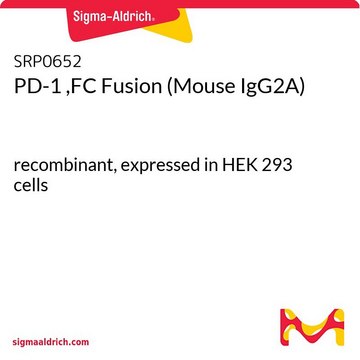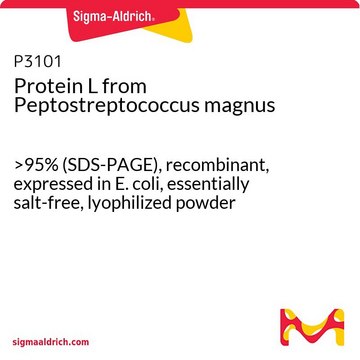08062
Protein G′ aus Streptococcus sp.
recombinant, expressed in E. coli
Synonym(e):
IgG F(c)-Rezeptor
Anmeldenzur Ansicht organisationsspezifischer und vertraglich vereinbarter Preise
Alle Fotos(1)
About This Item
Empfohlene Produkte
Biologische Quelle
bacterial (Streptococcus sp.)
Qualitätsniveau
Rekombinant
expressed in E. coli
Form
lyophilized solid
Mol-Gew.
~30 kDa
Kapazität
~5 mg/mg, solid binding capacity (IgG)
Lagertemp.
−20°C
Allgemeine Beschreibung
Protein G, a cell wall protein, is obtained from group G streptococci. The extracellular part of this protein is made of two/three small domains or serum albumin binding (GA domains) and two/three immunoglobulin (IgG) binding domains (B domains).
Genetically engineered truncated protein G; retains affinity for IgG, but lacks albumin and Fab binding sites and membrane-binding regions.
Anwendung
Protein G′ from Streptococcus sp. has been used in in vitro actin labeling assay.
Biochem./physiol. Wirkung
Protein G can bind all the human and mouse IgG subclasses. It can bind to both the fragment crystallizable (Fc) and antigen-binding fragment (Fab) components of the antibody.
Physikalische Form
lyophilisiertes Pulver in einem Tris-HCl-Puffer, pH 7.5
Lagerklassenschlüssel
11 - Combustible Solids
WGK
WGK 3
Flammpunkt (°F)
Not applicable
Flammpunkt (°C)
Not applicable
Persönliche Schutzausrüstung
Eyeshields, Gloves, type N95 (US)
Hier finden Sie alle aktuellen Versionen:
Besitzen Sie dieses Produkt bereits?
In der Dokumentenbibliothek finden Sie die Dokumentation zu den Produkten, die Sie kürzlich erworben haben.
Kunden haben sich ebenfalls angesehen
Archana Kumari et al.
The EMBO journal, 39(14), e104006-e104006 (2020-06-23)
Cellular studies of filamentous actin (F-actin) processes commonly utilize fluorescent versions of toxins, peptides, and proteins that bind actin. While the choice of these markers has been largely based on availability and ease, there is a severe dearth of structural
Unser Team von Wissenschaftlern verfügt über Erfahrung in allen Forschungsbereichen einschließlich Life Science, Materialwissenschaften, chemischer Synthese, Chromatographie, Analytik und vielen mehr..
Setzen Sie sich mit dem technischen Dienst in Verbindung.











